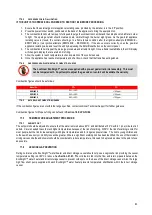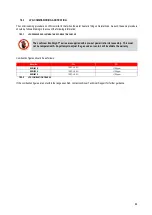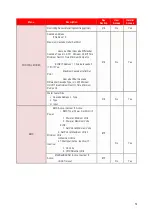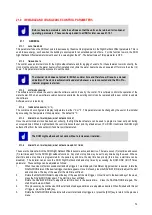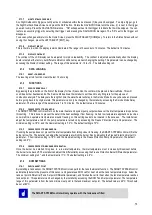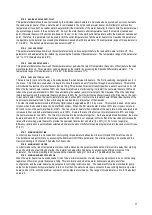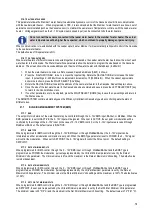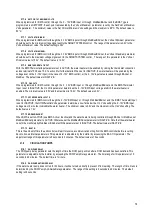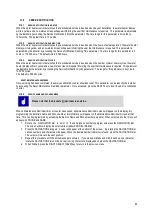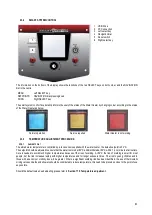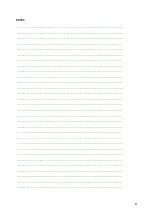
77
21.6.3
MAXIMUM
CASCADE
SET
POINT
This parameter determines the set point used by the individual water heaters in a Cascade when a system sensor is connected to
the Leader water heater. When a water heater is commanded to fire by the Leader water heater, it will attempt to achieve this
temperature at its outlet. The Leader water heater will limit the modulation of the water heater(s) in order to hold the temperature at
the system supply sensor to the user set point. If any of the water heater outlet temperatures reach the maximum cascade set
point, that water heater will then modulate down on its own in order to keep its outlet temperature within the maximum cascade set
point. Therefore, this parameter can be used to limit the outlet temperatures of all the water heaters in a Cascade this parameter
is adjustable by the installer by accessing the Maximum Cascade Set Point parameter. The temperature range of this parameter is
0°C to 88°C. The default maximum cascade set point is 85°C.
21.6.4
CASCADE
OFFSET
This parameter determines how much the temperature must go above set point before the lead water heater will turn off. This
parameter can be adjusted by the installer by accessing the Cascade Offset parameter. The temperature range of this parameter
is 0° to 11°C the default value is 6°C.
21.6.5
CASCADE
DIFFERENTIAL
This parameter determines how much the temperature must go below the turn off temperature (Set point + Offset) before the lead
water heater turns on. This parameter can be adjusted by the installer by accessing the Cascade Differential parameter. The
temperature range of this parameter is 0°C to 33°C the default value is 11°C.
21.6.6
CASCADE
TYPE
(L/L
/
EFF)
There are two (2) options for the way a Cascade divides the load between its heaters. The first is Lead/Lag, designated as L/L in
the menu. This method is used when it is desired to have the least amount of total flow through the water heaters. This method
will modulate the last two (2) water heaters that are firing. This provides for smooth transitions when a water heater turns on or off.
When the last water heater reaches 100% and the calculated load is still increasing, it will start the next water heater at 20% and
reduce the previous water heater to 80%, thus eliminating the sudden jump in total output of the Cascade. When the calculated
load is decreasing and the last water heater gets down to 20% fire, it will hold it there and start lowering the firing rate on the next-
to-last water heater. When the next-to-last water heater reaches 20%, it will turn the last water heater off and raise the rate of the
next-to-last water heater to40%, thus eliminating the sudden drop in total output of the Cascade.
The other Cascade divider method is Efficiency Optimization, designated as EFF in the menu. This method is used, as the name
implies, when it is desired to have the most efficient system. When the first water heater reaches 100% rate, it lowers its rate to
50% and turns on the next water heater at 50%. The two (2) water heaters then modulate at the same rate. As the calculated load
increases further and both water heaters ramp up to 100%, it lowers the rate of the first two (2) water heaters to 67% and brings
the next water heater on at 67%. The three (3) water heaters then modulate together. As the calculated load decreases, the water
heaters will reach 20%, at which time the last water heater (the third in our example) will turn off and the Cascade will increase the
rates of the remaining water heaters to provide the equivalent total output as before ((3 x 20%) / 2= 30% in our example).
Efficiency optimization is automatically selected when water heaters of different sizes are programmed into the Leader control (see
21.6.7
MINIMUM
ON/OFF
TIME
In order to prevent units in a Cascade from short cycling, this parameter defines the minimum ON and OFF time for each unit.
The installer can adjust this time by accessing the Minimum On/Off Time parameter. The minimum setting is 0 seconds and the
maximum setting is 10 minutes. The default is 30 seconds.
21.6.8
MINIMUM
NEXT
ON
TIME
In order to reduce the risk of temperature overshoot with a Cascade, this parameter defines the minimum time delay from starting
one unit until the next unit may be started. The installer can adjust this time delay by accessing the Minimum Next on Time
parameter. The minimum setting is 0 minutes and the maximum setting is 10 minutes. The default is 60 seconds.
21.6.9
MINIMUM
NUMBER
OF
PUMPS
ON
When the water heater is a Cascade Leader, it can force a minimum number of water heater pump outputs to be on continuously,
regardless of how many water heaters are firing. This is normally used when the water heaters are piped in a full-flow
configuration, and the water heater pump outputs are controlling isolation valves. The Leader will force the water heater pump
output on the highest priority water heater to turn on first, then the water heater pump output on the second highest priority water
heater, and so forth, until the minimum number of pump outputs are turned on. The range of this parameter is 0 to 8. The default
value is 0.
Summary of Contents for ECOKNIGHT EKW116CE
Page 28: ...28 Max distance between brackets ...
Page 29: ...29 ...
Page 30: ...30 ...
Page 34: ...34 ...
Page 35: ...35 ...
Page 55: ...55 15 8 WIRING DIAGRAM 15 8 1 WIRING DIAGRAM ...
Page 56: ...56 15 9 LADDER DIAGRAM 15 9 1 LADDER DIAGRAM ...
Page 87: ...87 ...
Page 88: ...88 ...

